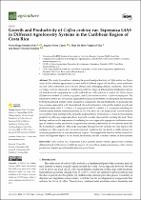| dc.contributor.author | Morales Peña, Victor Hugo | |
| dc.contributor.author | Mora Garcés, Argenis | |
| dc.contributor.author | Virginio Filho, Elias de Melo | |
| dc.contributor.author | Villatoro Sánchez, Mario | |
| dc.date.accessioned | 2024-10-15T15:47:47Z | |
| dc.date.available | 2024-10-15T15:47:47Z | |
| dc.date.issued | 2024-10-01 | |
| dc.identifier.uri | https://repositorio.catie.ac.cr/handle/11554/12680 | |
| dc.description.abstract | This study focused on evaluating the growth and productivity of Coffea arabica var. Esperanza L4A5 in different agroforestry systems in the Caribbean region of Costa Rica, a non-traditional area for coffee cultivation due to its low altitude and challenging climatic conditions. Three tree coverages were investigated, in combination with two types of differentiated fertilization (physical and chemical), comparing the results with full sun coffee plots as a control: (1) Albizia saman, (2) Hymenaea courbaril + Erythrina poeppigiana, and (3) Anacardium excelsum + Erythrina poeppigiana. The results showed that tree associations significantly reduced the mortality of coffee plants and increased both the height and mature cherry production compared to full sun treatments. In particular, the tree coverages associated with chemical and physical fertilization achieved the highest growth and production rates, with A. excelsum + E. poeppigiana and H. courbaril + E. poeppigiana standing out with maximum mature cherry productions of 3.35 t/ha and 3.28 t/ha, respectively. Growth analysis revealed that rapid initial growth, especially under chemical fertilization, is crucial for maximizing productivity, although a rapid slowdown in growth was also observed after reaching the peak. These findings underscore the importance of combining tree coverages with appropriate fertilization strategies to optimize coffee production in agroforestry systems, particularly in low-altitude areas like the Costa Rican Caribbean. This study concludes that agroforestry systems not only improve the resilience of coffee crops to adverse environmental conditions but can also be a viable strategy for increasing productivity in non-conventional regions. This suggests the need for further research to assess the long-term impacts on soil health, biodiversity, and the economic viability of these systems. | es_ES |
| dc.format.extent | 27 páginas | es_ES |
| dc.language.iso | en | es_ES |
| dc.relation.ispartof | Agriculture | es_ES |
| dc.relation.uri | https://doi.org/10.3390/agriculture14101723 | es_ES |
| dc.subject | Coffea arabica||Coffea arabica||Coffea arabica||Coffea arabica | es_ES |
| dc.subject | Mejoramiento genético||genetic improvement||melhoramento genético||undefined | es_ES |
| dc.subject | Sistemas agroforestales||agroforestry systems||sistemas agroflorestais||systèmes agroforestiers | es_ES |
| dc.subject | Sombra||shade||sombra||ombre | es_ES |
| dc.subject | Logística||logistics||undefined||logistique | es_ES |
| dc.subject | Tasa de crecimiento||growth rate||taxa de crescimento||taux de croissance | es_ES |
| dc.subject | Costa Rica||Costa Rica||Costa Rica||Costa Rica | es_ES |
| dc.subject | Índice de crecimiento | es_ES |
| dc.subject | Differentiated fertilization | es_ES |
| dc.subject | Coffee cherry production | es_ES |
| dc.subject.other | Sede Central | es_ES |
| dc.title | Growth and Productivity of Coffea arabica var. Esperanza L4A5 in Different Agroforestry Systems in the Caribbean Region of Costa Rica | es_ES |
| dc.type | Artículo | es_ES |
| dc.identifier.status | openAccess | es_ES |
| dc.subject.sdg | ODS 12 - Producción y consumo responsables | es_ES |


